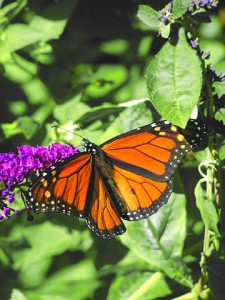Migrating monarchs are on the move

Barbara and I are sitting out in the orchard in the sunshine and one of those noisy helicopters just went over. As the noise passed and things got back to normal, we noticed three monarch butterflies dancing by along the fence, heading south on their fall migration. What remarkable insects they are. Weighing a bit more than a feather, these fragile little insects fly through storms and rains like those we’ve been having lately.
What draws them here to our garden are the butterfly bushes we put in years ago, and they really work. There is a pleasant smell to them, something like a lilac bush. Sometimes we’ll have five or six butterflies at a time flitting about the bushes gathering nectar from the variety of colorful blossoms.
We have some concern about the area where the monarchs are going as they pass by on their long journey that will eventually wind up in Mexico. Loss of habitat and other pressures over the years have brought their population down to an all-time low. With help from interested organizations, it is hoped this area will be well protected in the future.
The monarchs are the only butterflies to make such a long two-way migration every year. Though they usually fly alone, they will cluster at night while moving southward. We witnessed this while working at the Fire Island Seashore, where hundreds of these colorful butterflies made a stop one night on a cedar tree near where we were living. I was up early the next morning to watch as they slowly woke in the morning sun and warmed their wings to ready themselves for the long journey ahead. What a magnificent sight it was — one I will always remember.
We see others in our back pasture that are starting to make their way on their migration south. A Cooper’s hawk just flew over and landed on a limb high in the old cherry tree. When this fellow is around everyone seeks shelter. One bird must have missed seeing the hawk in time and provided the hawk with a meal, as evidenced later by the clump of feathers below where the hawk landed.
This migration we speak of is all part of the cycle that moves out of the cold and into warmer parts of the world. Some will go just as far as the warmer southern states, while others will continue on, some going even as far as the Caribbean. Some — like the little hummingbird that visited us just last week — will, believe it or not, fly nonstop across the Caribbean on the way far south; remarkable endurance for such a fragile little bird. The ruby-throated hummingbirds that we see in our area are usually by themselves and make the long flights south alone.
When we first came down into the pasture a mockingbird was guarding his supply of Russian olive. He will challenge any bird that comes into his area with the idea of having a feast of berries. Each community has its own mockingbird. When we go down to the causeway to take a walk on the beach and we hear the lapping of the waves, in the background we can hear the mockingbird singing his heart out. It would be wonderful if more people could see and hear this bird, for it has an enormous repertoire of songs.
As we get up to head back to the house something catches my eye — a little bird has flown up on the fence. It’s a little flycatcher. It will stay here as long as there are insects in the air. It waits patiently for some movement on the ground, goes after it and then lights back up on the fence to wait for a passing insect that it can snatch out of the air.
It stays here quite late in the season, but eventually it will have to leave when it turns cold because there will be no insects moving. It’s surprising how long it will stick around. We have seen a single individual that has been able to find insects to catch into November, when ice has covered the pond. Somehow it can find a spot where warmth still breeds insects.
As we leave the garden and head for the house we can see hundreds of starlings have come to pick over the leaves that have started to cover our lawn. I’ve seen this phenomenon of turning over leaves with other birds, such as the grackle, as they pass through. Evidently this activity is part of their fattening up before they leave on their long migration south. This group of birds arrived on the lawn and quickly moved across it, much like a Panzer division, and then they were gone.





